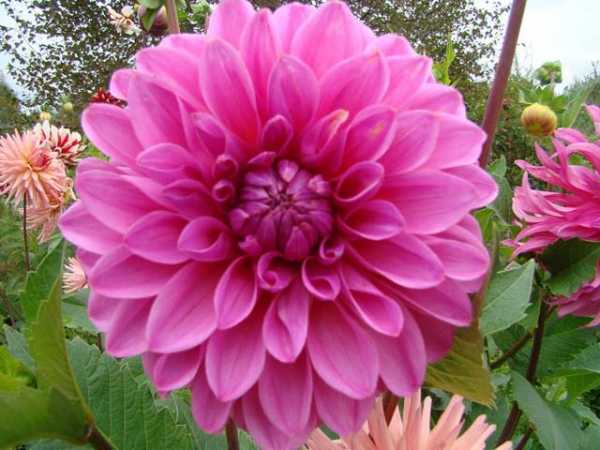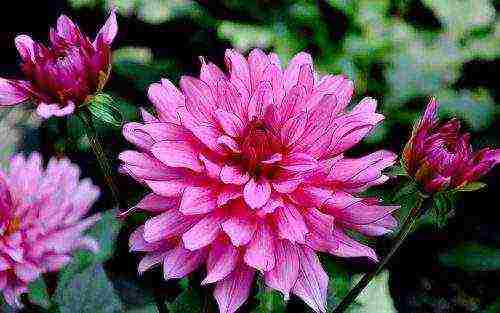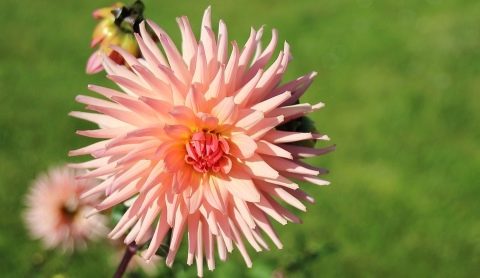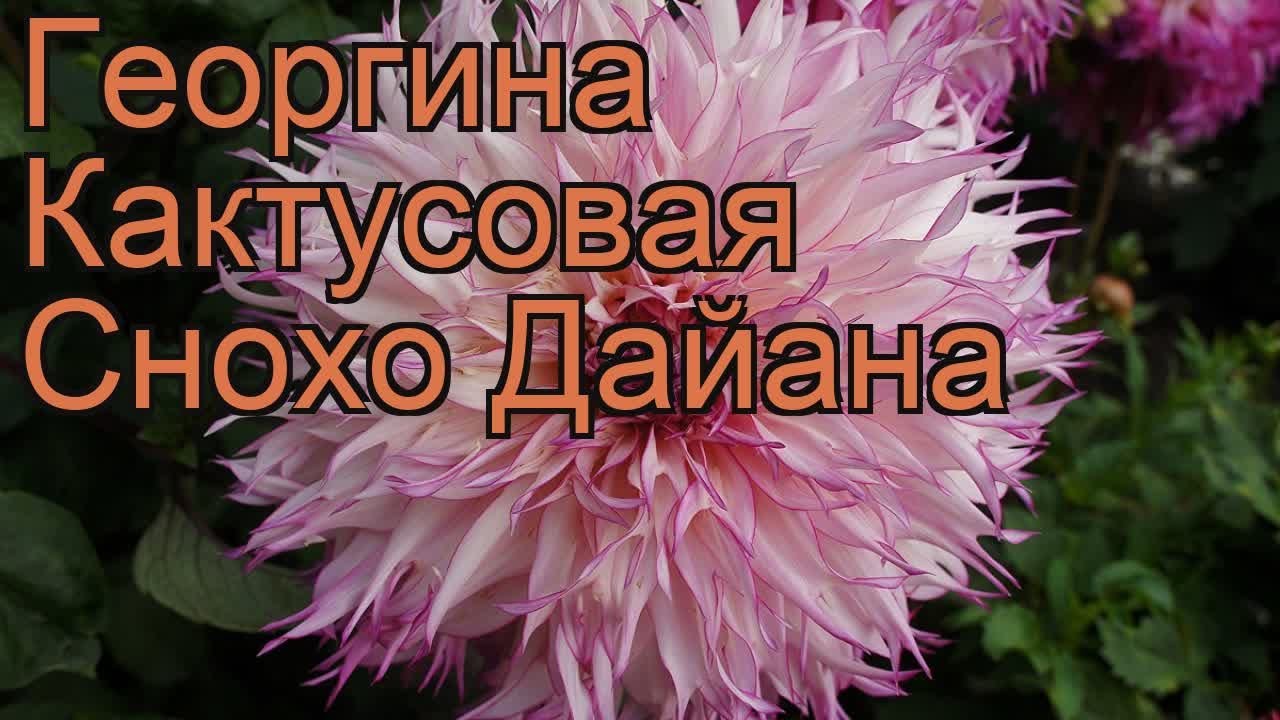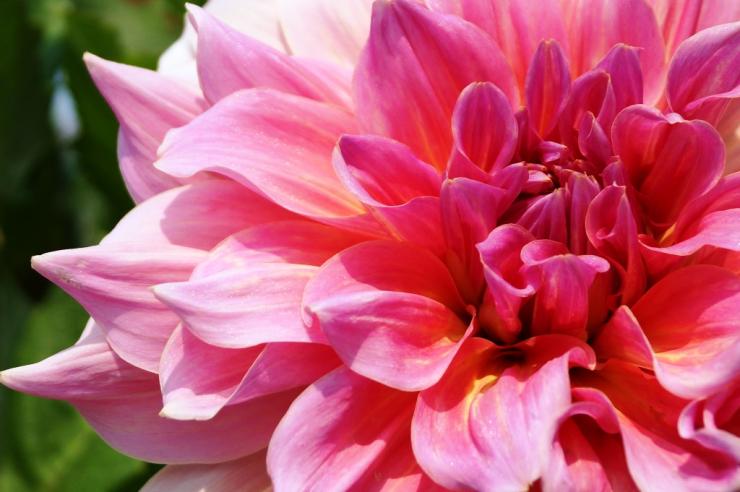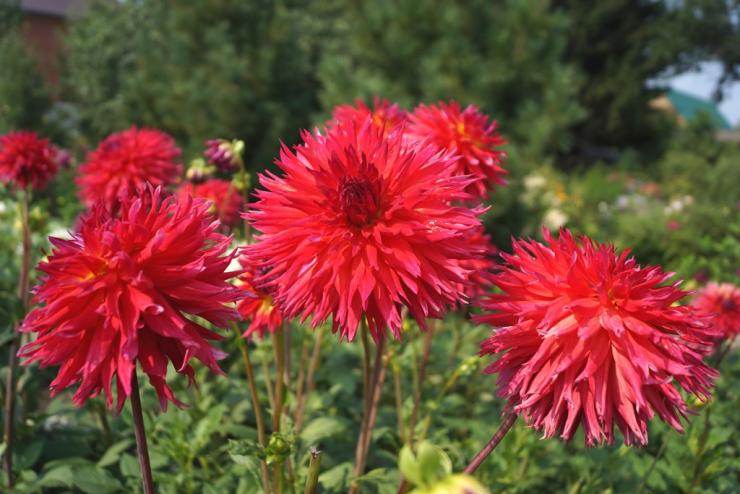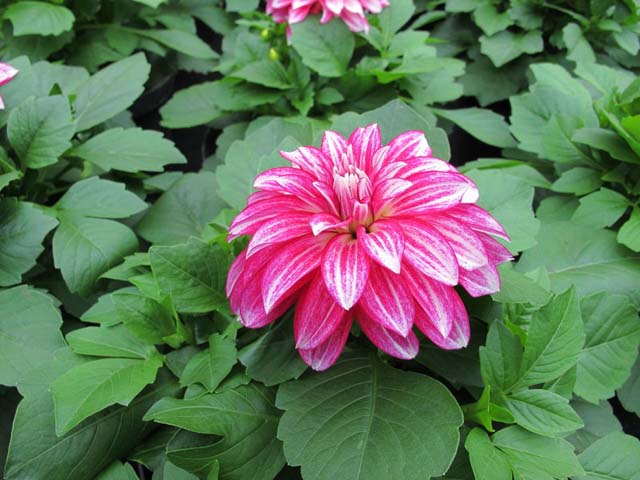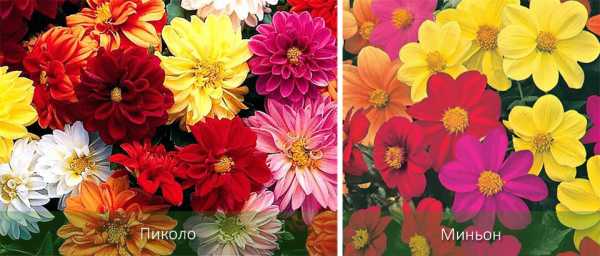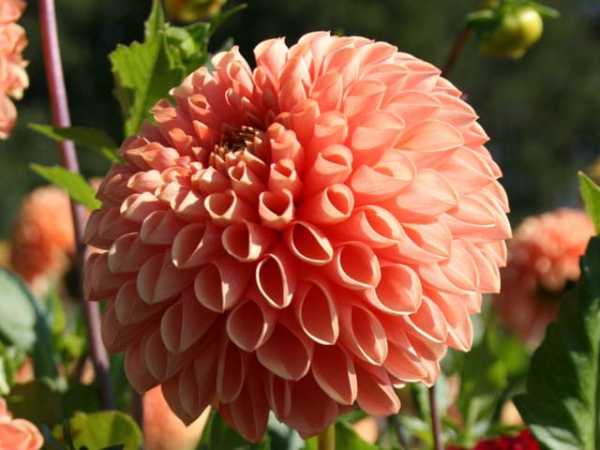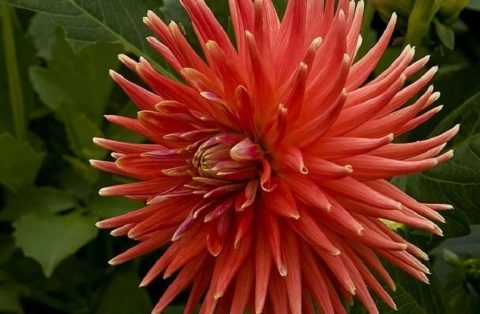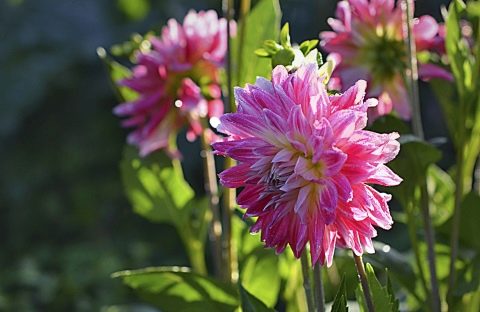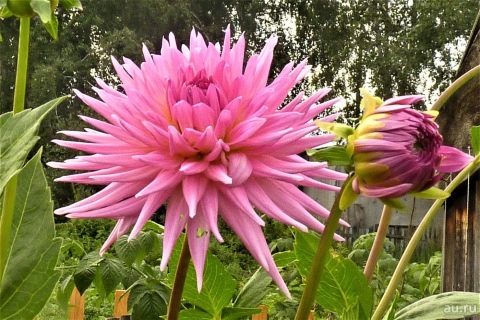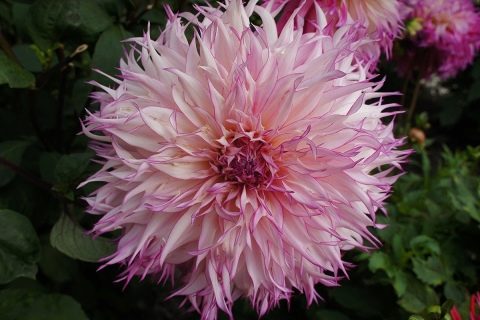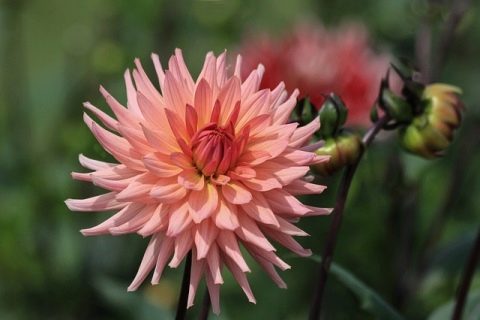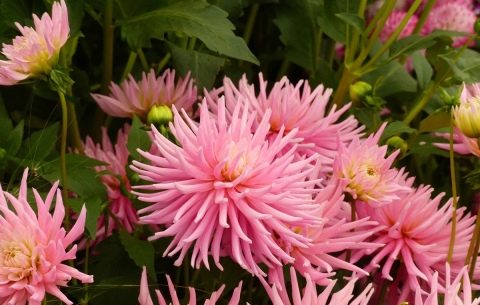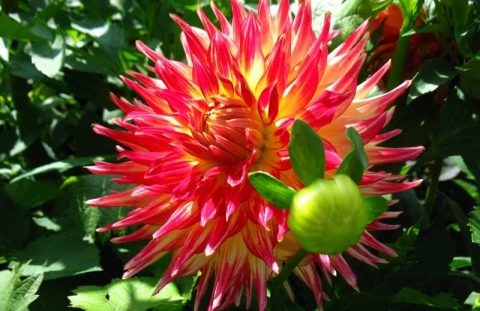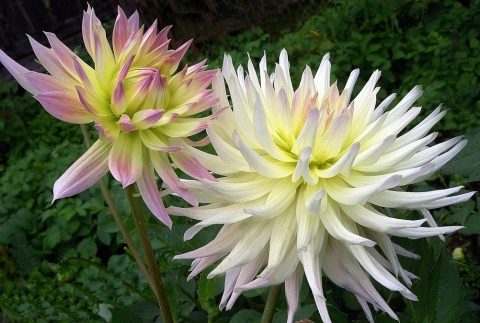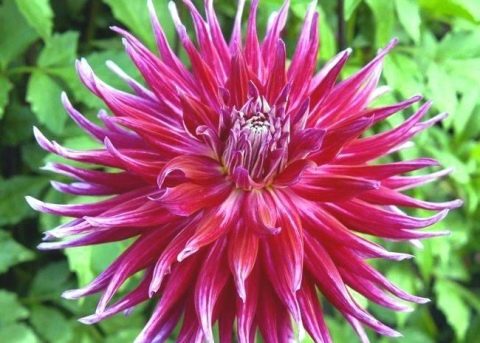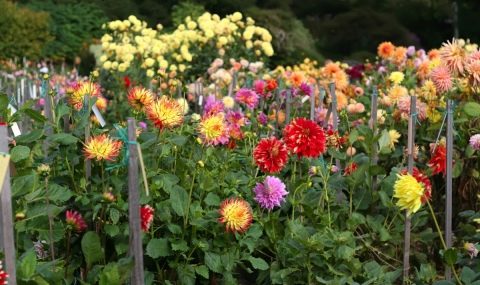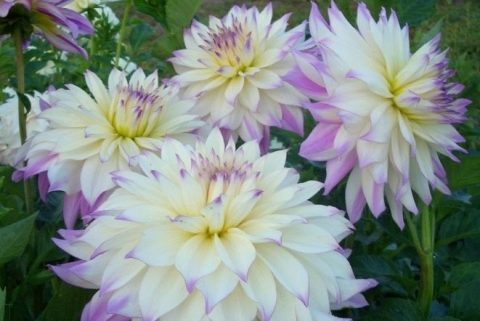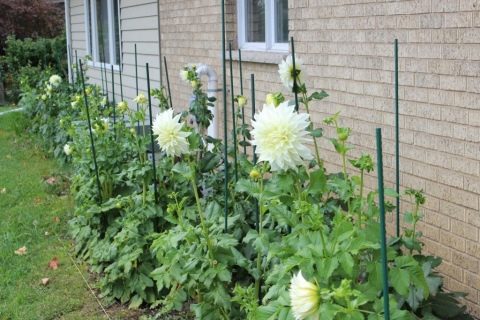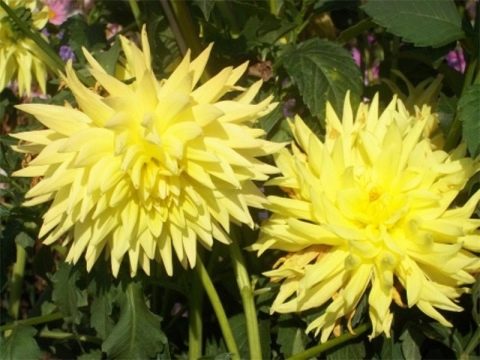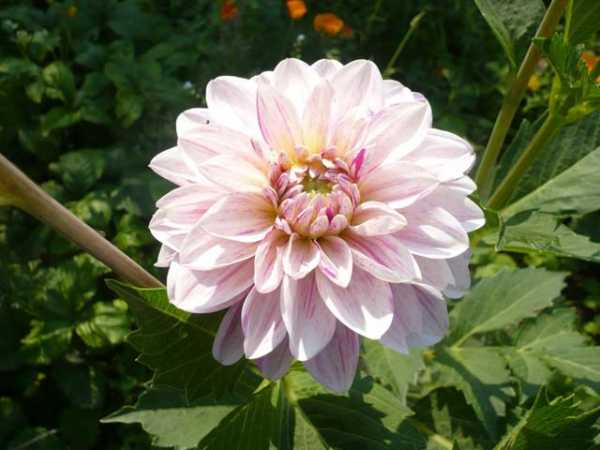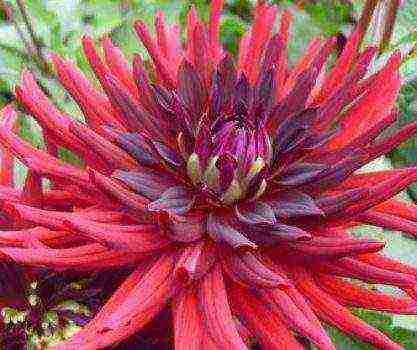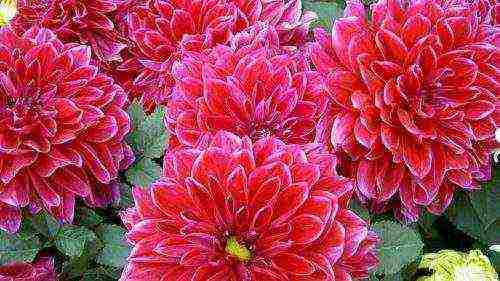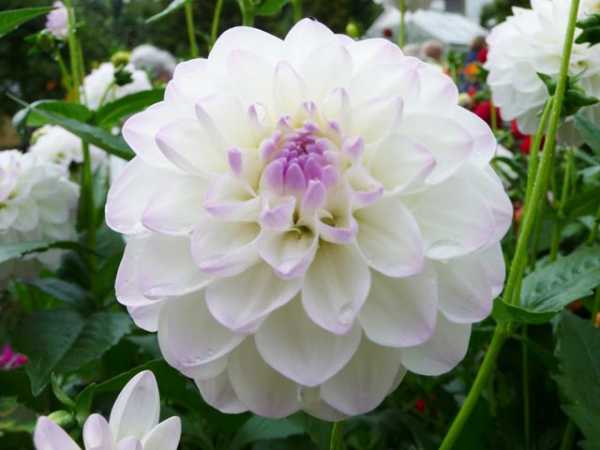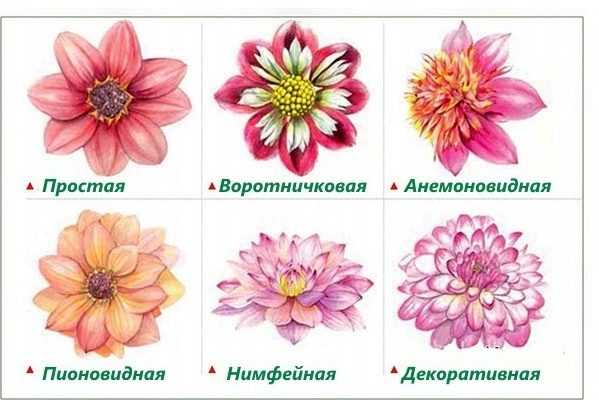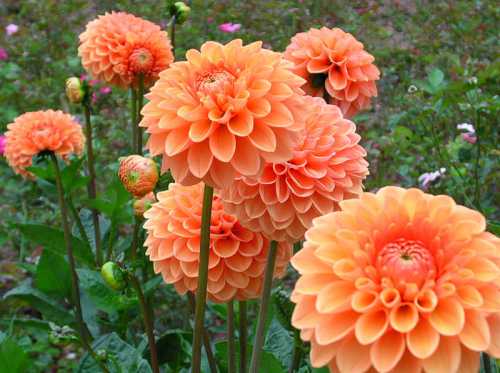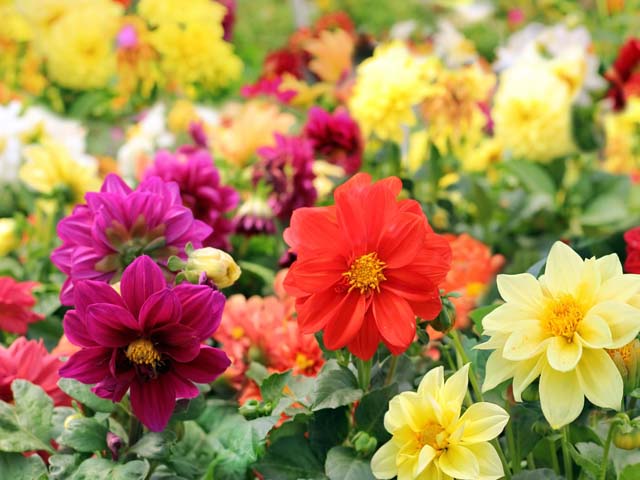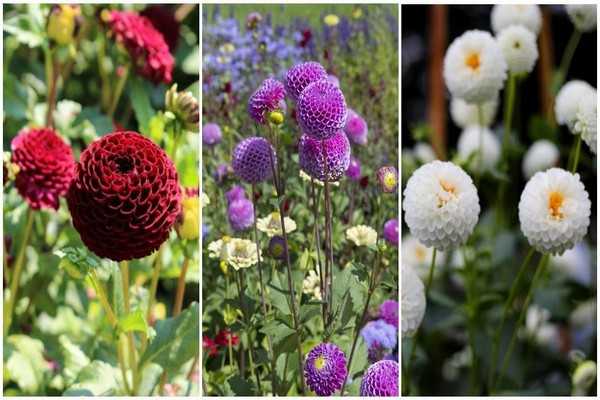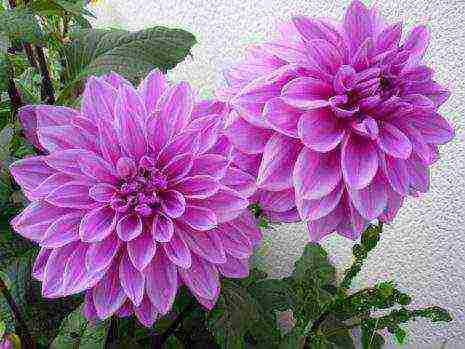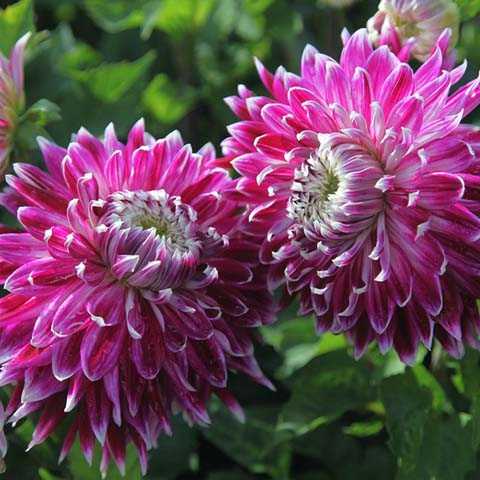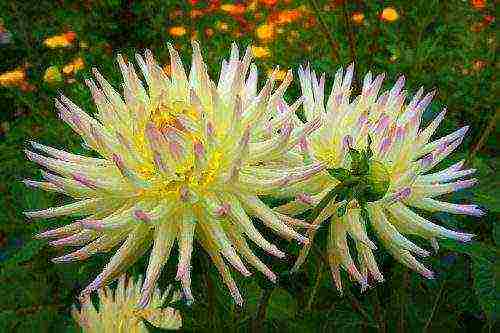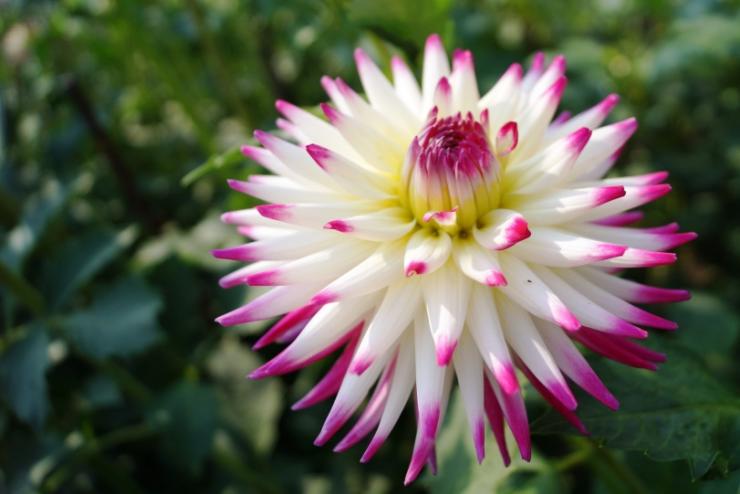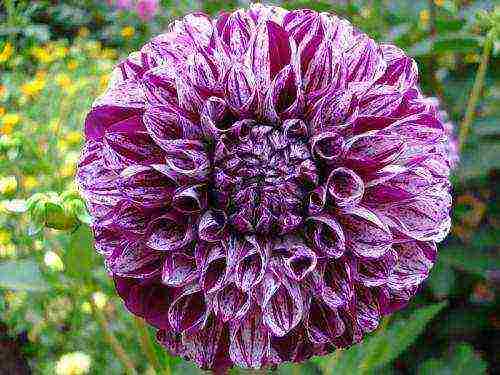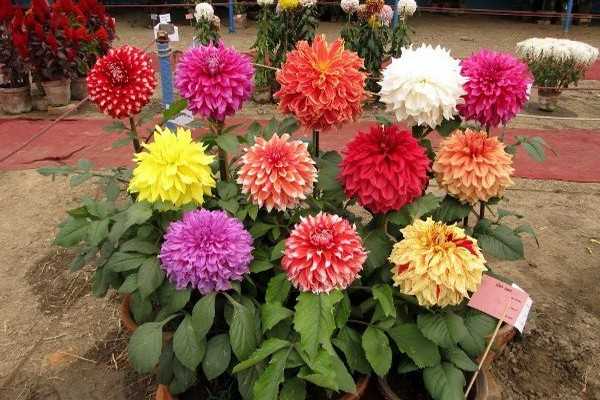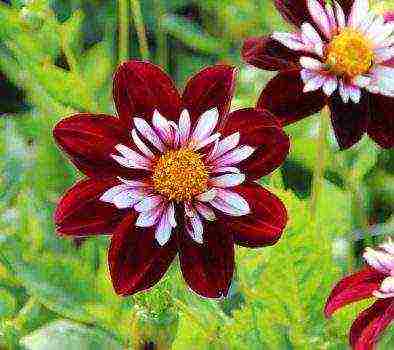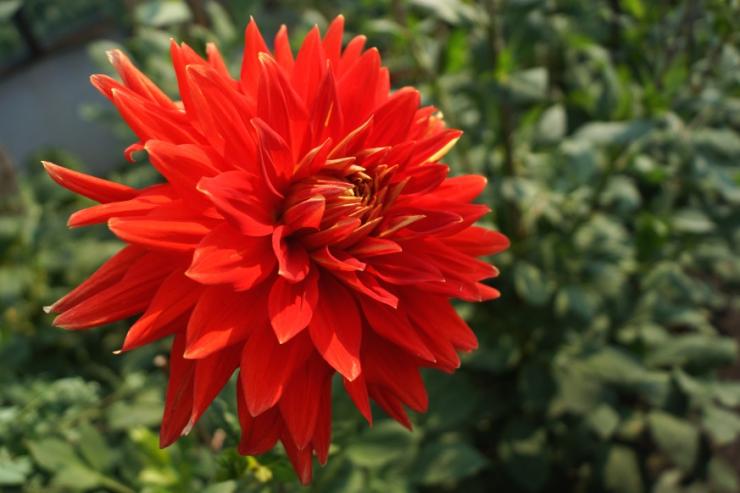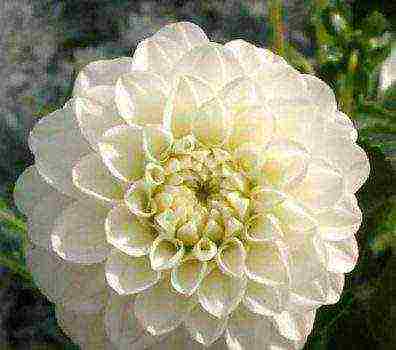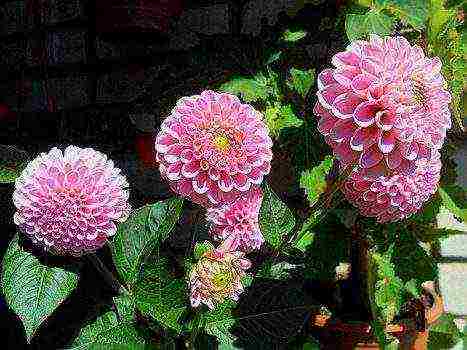Using dahlias in garden design
For all countries with severe winters, including the middle lane, dahlias are exclusively seasonal plants. In the open field, they do not winter and need annual storage outside the soil. But this does not at all limit the scope of their use. The magnificent variety of dahlias allows them to be incorporated into almost any composition.
There are no stylistic restrictions on the use of dahlias in the garden. They are suitable for country style, romance, regular trends, modern trends and even modern. There is only one limitation - the need to carefully calculate the color scheme of the ensembles. Dahlias are good not in colorful, sharp combinations, but in the selection of harmonious color pairs.
Dahlias can be used as a solo plant, in monogroups, in any group mixed plantings. This plant is planted in combination with perennials and other seasonal accents, introduced into groups with ornamental shrubs and trees, and used to fill empty spaces. Dahlias are also irreplaceable as a temporary camouflage for communications and buildings.
Dahlias look great in mixed mixborders when placed as seasonal accents and introduced into summer and digging sites. But still, dahlias are more often planted in classic rabatkas, groups, arrays, free compositions. A single dahlia flower garden or a spot on your lawn is a garden classic.
Large and abundant varieties can be placed in separate bushes. But the most interesting effects are provided by mixing varieties with different heights, colors, shapes of inflorescences. For compositions with dahlias, a strict ranking from undersized to medium and high varieties must be observed.
Low-growing varieties are associated with border planting, colorful ribbons near paths or on narrow strips of soil. But both medium and tall varieties of dahlias can be used to create masking or dividing lines.
Many undersized dahlia varieties are great for potting. Even medium-sized and tall cultivars can be planted in large pots and pots, used to decorate a terrace or recreation area, to highlight the path and at the entrance to the house. Dahlias require deep and spacious containers. Caring for them is no different from growing any other potted tuberous. Except, perhaps, great opportunities to change the timing of flowering: planting for distillation, an early start allow you to decorate gardens in bloom with dahlias even in late spring, stretching the season of your beloved autumn queen for the entire garden year.
Dahlias are a valuable cut crop. Gorgeous, most often terry varieties are constant participants in autumn bouquets. The main criterion for a variety for cutting is the length and strength of the peduncles. Cut dahlias last for a long time, but for this the flowers must be cut during their full blooming and in the early morning.
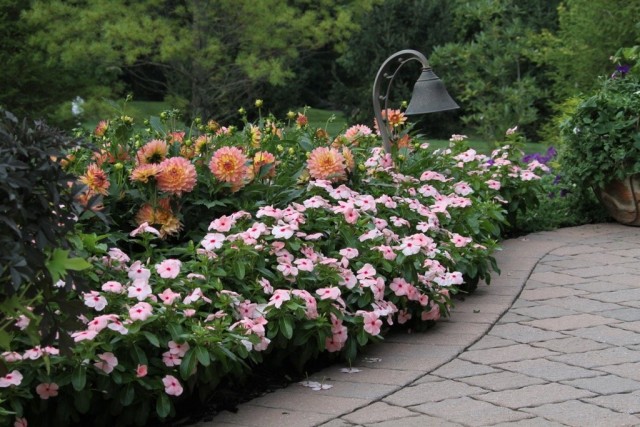 Dahlias are great with any plants - both perennial and seasonal. Longfield gardens
Dahlias are great with any plants - both perennial and seasonal. Longfield gardens
Main varieties with photos
The classification of these plants is associated with the structure, as well as the shape of the flower itself. At the moment, there are 12 classes of dahlia. However, more and more new classes are gradually appearing and this is associated with the formation of new varieties. Below are the varieties that are most popular:
Simple
They have one row of petals, the diameter of the flowers is 10 centimeters. The height of the bush, as a rule, does not exceed 45-60 centimeters. The main varieties are: Princess Marie Jose pink, Yellow Hammer - yellow, and Orangeade - orange-red.
Anemone
There are 1 or more rows of marginal petals. In the middle, they are tubular, elongated. The diameter of the inflorescences does not exceed 10 centimeters, and the height of the bush can be 60–90 centimeters. The main varieties are lilac-yellow Lucy, Vera Higgins bronze and red Comet.
Collar
The diameter of the flowers is about 10 centimeters, and the height of the bush can reach 75-120 centimeters. There is 1 marginal outer row of petals, directly along its top there is another row of twisted and short petals of a different color, which outwardly resembles a collar. The main varieties are gold with scarlet La Gioconda, Chimborazo cream with reddish, Claire de Luna cream with yellowish.
Peony
The diameter of the flowers is 12-15 centimeters. Marginal flat petals are located in 2 or more rows, and tubular petals are located in the central part. The height of the bush is 75-120 centimeters. The main varieties are: Symphonia crimson red and lilac Fascination.
Decorative
The diameter of the double flowers varies from 8 to 25 centimeters, and the height of the bush can reach 60 centimeters. Main varieties: small orange David Howard, large yellow Thames Valley, and very large purple Jocondo.
Spherical
Round, rarely slightly flattened double flowers in diameter can reach 8-15 centimeters. The height of the bush is 90-120 centimeters. The main varieties are the peach-red Crichton Honey, the reddish Doreen Hayes and the yellow Esmonde.
Pompom
The diameter of the spherical flowers is 5 centimeters or more. Rolled edge petals have a round or blunt end. The height of the bush is 90-120 centimeters. The main varieties are Hallmark lavender, light purple Willo's Violet and pinkish Noreen.
Cactus
The diameter of the double flowers can be equal to 8-25 centimeters or even more, and the height of the bush is from 90 to 150 centimeters. The marginal petals are narrow, pointed and coiled. Main varieties: rather large reddish Visit, very large pink Danny, miniature yellow Pirouette, small red Doris Day.
Semi-cactus
The diameter of the double flowers varies from 8 to 25 centimeters, and the bush in height can reach from 90 to 150 centimeters. The marginal petals are folded in the direction from the middle to the tips. The main varieties are very small Yellow Moods in yellow, small White Swallow in white, rather large yellows Nantenan and medium-sized orange Autumn Fire.
Nymphae
Outwardly, double flowers are similar to water lilies, they have the correct shape and are distinguished by their grace. Their diameter can vary from 7 to 20 centimeters, and the bush reaches 70–130 centimeters in height. The main varieties are light pink Gehry Hawk, pure white Genette and lilac Brushstrokes.
Mixed
This includes those varieties that are not similar to those described above.
However, such flowers have not only diverse flower shapes, they also have a very wide palette of colors. So, you can even meet a black dahlia, or rather a black and red color. In such a plant, many special pigments have accumulated - anthocyanins. However, all breeders in the world strive to create a blue dahlia. However, unfortunately, they have not succeeded so far, but the hope of someday seeing this miracle remains.
Garden. Dahlias
Annual dahlias funny guys: reproduction
Flowers are propagated by funny guys in two ways - by seeds and tubers. Of course, it is better to choose the second option, since you can determine the quality of the planting material and make sure of the plant variety. However, tubers do not always take root in the open field.
When buying seeds, there is a great chance that the flowers that have sprung up will be different from those shown on the package.
To be sure that the dahlia grains are exactly what you need, it is better to collect them yourself. To do this, wait until the end of flowering, and remove dried seeds from the strongest plants. Store them in a paper bag at twenty to twenty-five degrees.
As for reproduction by tubers, the main rule is to find the right time for planting. This will allow a good root tuber to form in one season.
On this topic:
BACK
FORWARD
1 of 3
When the first frosts pass, you can already start digging dahlias.To keep the flowers in good condition until next season, several procedures are necessary. First of all, in order to maintain moisture, the planting material is coated with clay. After that, it should be placed in boxes, preferably cardboard ones, and placed in a dark, cool room. It is best to choose a basement. On the boxes, sign the shade of the dahlia, or rather glue a photo with the appearance of the plant, so that when planting, you can correctly plan the area in relation to the color scheme.
The roots that survive in such conditions are planted in the soil in May. In general, dahlias are perennial plants, however, due to the fact that they are not able to withstand cold and frost, in our climate this culture is considered an annual one.
So, without putting in too much effort and expense, you can add a great look to your garden thanks to the different colors of the fun guys.
Planting dahlias with tubers

Planting dahlias in the ground
Dahlia tubers are planted in open ground after the threat of spring frosts has passed, and the soil warms up to a depth of 20-25 cm.To exclude the possibility of freezing of the planted plants, the shoots can be sprinkled with soil, sawdust or covered with cardboard boxes overnight.
When placing plants on a site, their height and color of inflorescences are taken into account. Varieties with dark flowers look spectacular next to light varieties.

Pegs next to the grown dahlia bushes
Dahlias are planted in such a way that the soil layer above the root collar does not exceed 5-6 cm. Before planting the tubers, pegs are driven into the bottom of the pit. They are needed in order to tie up the stems of adult plants to them in the future. The tubers are leaned against the pegs with their root necks, covered with soil and watered with warm water. The stakes can also be labeled with variety names.
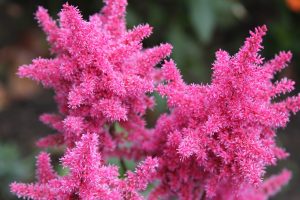
Astilba: 12 groups of varieties, description of the most common, care, reproduction (50 Photos & Videos) + Reviews
Chrysanthemum maiden
Chrysanthemum maiden is perfect as flowers for the border, another name is maiden's matrix.
This is a representative of the Aster family, which is used by gardeners as an annual due to the fact that it is extremely difficult to preserve the plant in winter in the middle climatic zone. In appearance, the flowers of maiden chrysanthemum resemble a large chamomile and retain the same color. Inflorescences 3-4 cm in diameter. Plant height varies from 25 to 70 cm. Leaves are pinnately dissected, light green in color.
Chrysanthemum fell in love with many gardeners for the reason that it perfectly withstands drought, cold and grows on almost all more or less fertile soils. For planting on the curb, dwarf varieties are used in their pure form, or in tandem with ageratum.
Did you know? The name "maiden chrysanthemum" comes from the fact that the action of the plant can relieve pain and inflammation that occurs in girls during menstruation.
Dahlia came to us from Mexico, it was used for landscaping by the ancient Indians, calling it various names, which in translation meant "a flower with a hollow stem." We will talk about annual varieties and hybrids of dahlias, and how they are better than perennials.
The height of annual plants varies from 80 to 120 cm, the diameter of the bud is from 10 to 12 cm. Up to 15 peduncles develop on one bush, which appear quite early and are pleasing to the eye throughout the summer, in contrast to perennials, which in the first year of planting and may not bloom at all. Flowers are baskets, the petals of which are painted in various bright colors (red, blue, white and their shades).
Another advantage of annual dahlias is ease of care and great resistance to diseases and pests. It is also worth noting that dahlias feel great in the middle climatic zone.
Did you know? The plant began to be called dahlia only in 1803, after the German botanist Karl Wildenov changed the Latin name and gave the flower a middle name in honor of the Russian botanist and geographer Johann Georgi.
The nasturtium family gave us another flower for the borders in the person of the annual and of the same name nasturtium, which is also popularly called "capuchin". The family contains about 90 species that came to us from Central and South America.
Important! There are also perennial varieties of nasturtium, so review the seed packaging carefully before purchasing. Beautiful annual flowers for your flower bed: clarkia, heliotrope, forget-me-not, rudbeckia, heliantemum
Beautiful annual flowers for your flower bed: clarkia, heliotrope, forget-me-not, rudbeckia, heliantemum.
Belongs to the Aster family, the genus has about 60 species, distributed in North and South America, as well as in Eastern India. Ageratum, depending on the variety, can be an annual or perennial, herb or shrub.
The plant has numerous branched stems varying in height from 10 to 50 cm. The leaves can be in the form of a diamond, triangle or oval, dark green in color with small light stripes. The flowers are very small, collected in small baskets, and those, in turn, are collected in large inflorescences. The buds are colored blue, white or pink.
Important! Ageratum juice can cause allergic reactions. In the role of border plants, dwarf or undersized variations are used.
They grow compact and have enlarged dense inflorescences.
In the role of border plants, dwarf or undersized variations are used. They grow compact and have enlarged dense inflorescences.
Plant care rules
The main care is to regularly air and water the containers of dahlias. During the germination period of tubers, one should not be zealous with moisture.
The thick tuberous root system contains a decent supply of water and nutrients. Therefore, the plant tolerates short periods of drought quite well. But excessive watering can lead to rotting of the sprouts. Therefore, at this stage, the tubers also do not need additional fertilization.
As soon as the tubers sprout, it is recommended to move the boxes to a cooler place (about + 15-16˚С).
So, in this article we examined the features of sprouting dahlia tubers after winter. Dahlias are very beautiful and elegant flowers. In gratitude for the good care, they will delight those around them with abundant multi-colored flowering.
Varieties for summer cottages
Among the many varieties, there are beautiful varieties that are deservedly in demand among dahlia lovers.
Mix of colors
If the package of seeds says "a mixture of colors" this will indicate that varieties with different shades of double flowers are presented. The height of the bushes will reach a meter mark. Flowering continues until the first frost. Recommended planting of seedlings in 40 cm increments.
Terry ball
The height of the bush is 115 cm pompom-type flowers, the diameter can reach 7 cm. The stems are strong and not branched, so the variety can be used for cutting. The variety is not whimsical and grows well in any areas other than those that are subject to flooding.
White Nordlicht
The most interesting thing is that it blooms in yellow, the flower diameter is 6 cm, it looks good in bouquets. The variety is drought-resistant.
Yellow crumb
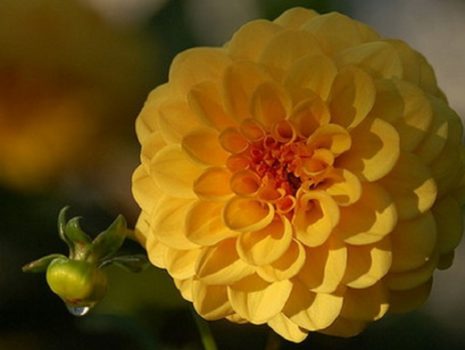
The height of the bush is only 50 cm, but it is strewn with yellow flowers with a diameter of 5.5 cm. Looks beautiful when decorating flower beds and flower beds.
Gretchen Heine
The bushes reach a height of 100 cm, they are highly spreading and have a slow growth. The inflorescences reach 6 cm in diameter and are strongly terry and have the shape of a ball. Up to 15 buds can bloom on one bush at the same time. Duration of flowering of a single inflorescence is 6 days.
Tall pompom dahlias
Among the pompom dahlias there is a group that is distinguished by its high growth of the bush - tall. Among the pompom dahlias, the most popular varieties are Ankress and Fatima.
Ankress
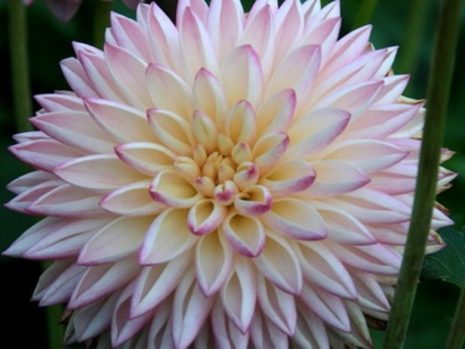
The color of the inflorescence of this dahlia is white and the diameter is 6 cm. They grow in height not lower than 115 cm, the leaf plates are densely located along the stem and have a dark green color. Up to 10 buds bloom on the bush at the same time.
Fatima
The bush of this variety grows to a height of 120 cm. The leaf plates are medium in size. Inflorescences of a bright pink shade with a diameter of 7 cm, blooms from July until the first frost.
Dahlias pompon dwarf
Dwarf dahlias grow no taller than 60 cm, and some varieties have magnificent inflorescences.
Willo's Surprise
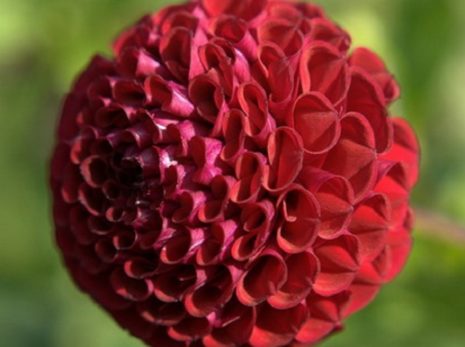
The height of the bush is only 45 cm and magnificent balls of inflorescences of a deep burgundy hue bloom on it. The bush is almost invisible behind the blooming flowers.
Small world
The height of the bush is 50 cm and absolutely white balls protrude on their peduncles 10 cm above the bush, they seem to hang in the air. The diameter of the flowers is only 5 cm, but there are so many of them that it seems as if there is snow and this is already at the end of June.
Types and varieties
Depending on the size of the stem, varieties of dahlias are:
- undersized or dwarf (15-30 cm high);
- medium-sized, the height of which is within 50-70 cm;
- tall, growing up to 120 cm.
Dahlias delight the eye with their large, beautiful inflorescences. Depending on the variety, plants can have a very different shape of the structure of the flower and petals. It is customary to distinguish between the following groups of dahlias.
- Simple (single-row) - usually these are undersized flowers with petals located in one layer, the diameter of the cap is about 10 cm.
- Anemonic - the petals in the middle are shorter than the outer ones, with dissected tips. Most often these are undersized varieties, no higher than 70 cm.
- Cactus - a variety with double inflorescences with long pointed petals-tubes. Stem height is about one meter. The inflorescences are bright, very voluminous.
- Decorative dahlias - stem height 120 cm, inflorescences of the correct round shape, double petals. Designed primarily for bouquets.
- Semi-cactus is a cross between cactus and decorative. The height of the bushes is 80-150 cm, the diameter of the inflorescence is up to 30 cm, the petals are elongated, begin to curl into a tube from the middle of the length.
- Spherical - so named because of the shape of the inflorescences in the form of balls with dense tubular petals. The diameter of the ball is 10-20 cm.
- Pompom - very similar to the previous type, the only difference is in size. The inflorescence of the pompom group is denser, 5-8 cm in diameter.
- Nymphaean - in shape they resemble a flower of a water lily or a lotus-nymphea (hence the second name "lotus-like"). The shape of the petals is flat, the texture is dense, the peduncle is elongated, the height is 1 m and higher, so the plant needs support.
- Collar dahlias (cuffed) - belong to the category of semi-double dahlias. The middle of the inflorescence consists of yellow tubular petals. The outer petals are longer than the middle ones and are colored differently. Thus, the flower seems to be wearing a kind of collar.
Let's take a closer look at some of the most popular varieties.
- "Funny boys". This variety is considered undersized: the height of an adult plant usually does not exceed 30 cm, although in some cases the bush can grow up to 60 cm.This variety is named because of its multi-colored color - the seeds form a variegated flower bed during germination. This variety does not form a tuber, therefore it must be cut in the first year immediately after flowering. The inflorescence is simple with flat petals and a yellow tubular middle. When opened, the diameter of the cap is 7-10 cm.
- "Vasilisa". The variety belongs to the dwarf category. This is a plant with a stem up to 15 cm high and large double flowers. The size of the inflorescences is 5-7 cm, their color may be different. The variety blooms almost until the first snow, suitable for decorating flower beds, balconies and terraces.
- "Bambino".This variety is also considered undersized and does not grow more than 25 cm. The inflorescences are terry, 6-7 cm in diameter, the color is different, mostly bright. Plants are used as the lower tier of the park landscape, decorating garden paths or decorating summer terraces.
- "Minion". Height up to 40 cm, flowers are simple, 6-9 cm in diameter. The color of the flower is either single or two-colored. The variety looks great as a border or delineation of flower beds.
- "Colarette Dandy". This variety belongs to the category of collar and is considered medium-sized - the plants grow up to half a meter, they are a mix of multi-colored flowers. Yellow middle surrounded by semi-double flounces.
- "Salute" - a dwarf bush with variegated petals, reaches a height of 25 cm, decorated with a large (about 8 cm in diameter) simple inflorescence.
- "Pompon". The bush is 120 cm high and has a branched system of stems, decorated with carved leaves and fluffy spherical inflorescences, reminiscent of a woolen pompom.
- "Opera". The plant is up to 30 cm tall, a voluminous flower with a small yellow center with double petals 7-10 cm in diameter. The color of the inflorescences is monochromatic, but varied: from pale yellow to bright coral.

